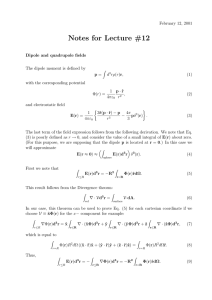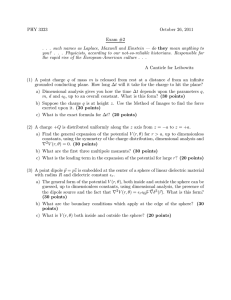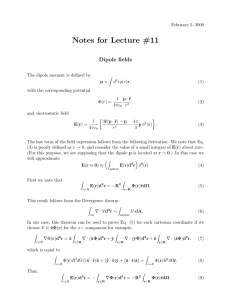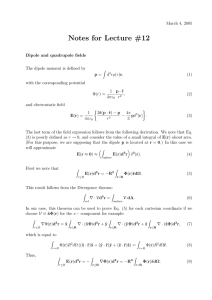Electromagnetic torque
advertisement
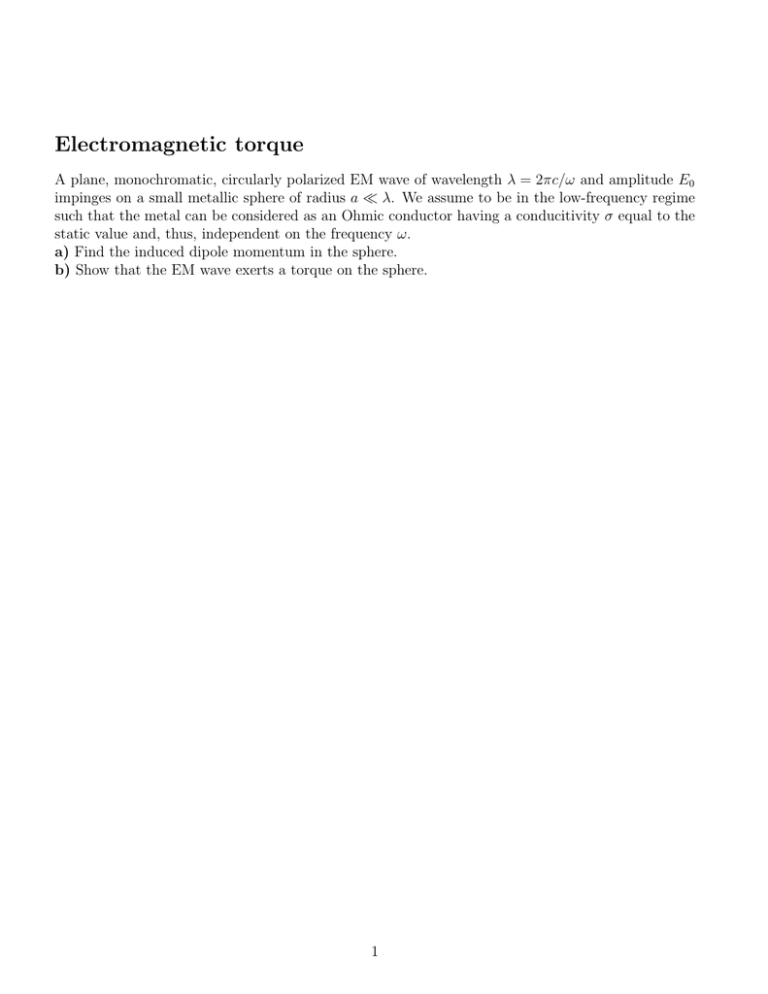
Electromagnetic torque A plane, monochromatic, circularly polarized EM wave of wavelength λ = 2πc/ω and amplitude E0 impinges on a small metallic sphere of radius a ≪ λ. We assume to be in the low-frequency regime such that the metal can be considered as an Ohmic conductor having a conducitivity σ equal to the static value and, thus, independent on the frequency ω. a) Find the induced dipole momentum in the sphere. b) Show that the EM wave exerts a torque on the sphere. 1 Solution a) We can write the EM wave as E(z, t) = E0 [x̂ cos(kz − ωt) − ŷ sin(kz − ωt)] = Re[E0 (x̂ + iŷ)ei(kz−ωt) ] , (1) where k = ω/c = 2π/λ. Since a ≪ λ, we can neglect both the spatial variation of the field across the volume of the sphere and magnetic induction effects, so that the sphere can be considered inside an uniform rotating field Ẽ0 = E0 (x̂ + iŷ) . (2) E0 (t) = Re Ẽ0 e−iωt , For harmonic fields a real conductivity σ is equivalent to a dielectric function ǫr = ǫ iσ =1+ , ǫ0 ωǫ0 (3) and we recognize that the problem is equivalent to that of a dielectric sphere in an uniform field. Thus the amplitudes of the internal electric field and the dipole momentum are given by 3 3Ẽ0 3iωτ Ẽ0 = =− Ẽ0 , ǫr + 2 3 + i(σ/ωǫ0 ) 1 − 3iωτ ǫr − 1 i(σ/ωǫ0 ) 3ǫ0 V p̃ = PV = ǫ0 χEint V = 3ǫ0 V Ẽ0 = 3ǫ0 V Ẽ0 = Ẽ0 , ǫr + 2 3 + i(σ/ωǫ0 ) 1 − 3iωτ Ẽint = where V = 4πa3 /3 and τ = ǫ0 /σ. By writing p 1 − 3iωτ = 1 + (3ωτ )2 e−iφ , tan φ = 3ωτ , (4) (5) (6) one obtains 3V ǫ0 Ẽ0 p̃ = p eiφ , 2 1 + (3ωτ ) i.e. p = Re 3V ǫ0 E0 p (x̂ + iŷ)e−i(ωt−φ) 2 1 + (3ωτ ) (7) ! . (8) Thus the dipole momentum rotates with a phase delay φ with respect to the electric field of the wave. b) The torque on a dipole is given by M = p × E0 . Since the angle between p and E0 is constant and equal to φ, we immediately find 3V ǫ0 E02 M = |p||E0 | sin φ = p ẑ sin φ . 1 + (3ωτ )2 2 (9) This is also given by the explicit calculation where we used 1 3V ǫ0 hMi = hp × E0 i = Re(p̃ × Ẽ∗0 ) = p Re(eiφ Ẽ0 × Ẽ∗0 ) 2 2 2 1 + (3ωτ ) 3V ǫ0 E02 3V ǫ0 Re(−2ieiφ E02 ẑ) = p = p ẑ sin φ , 2 1 + (3ωτ )2 1 + (3ωτ )2 Ẽ0 × Ẽ∗0 = E02 (x̂ + iŷ) × (x̂ − iŷ) = E02 (−ix̂ × ŷ + iŷ × x̂) = −2iE02 ẑ . 3 (10) (11)
